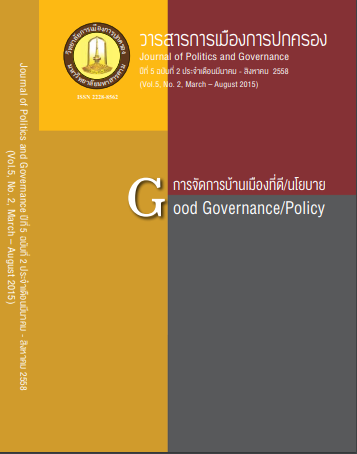The Strength of Community Welfare on Chinese Identity in Case of Bobae
Main Article Content
Abstract
The objective of this research is to investigate the strength of community welfare on chinese’s identity in case of Bobae, which has an affect on Bobae’s Community. This study is qualitative research through conceptual of Social Capital, Social Welfare, Assimilation which specify scope of the study area in Old Bobae market, nearby Thamma alley. The fact findings indicate that Chinese in Bobae depend on 3 identities. The first is Chinese Identity, which is similar as the whole chinese around the world as the customs, favorite days, rituals, etc. For example, Chinese New Year’s day, Chinese Midyear Remembrance Ceremony Day, Wedding Ceremony, Funeral Ceremony (Kong-Tek), etc. The second is Shantou Identity, Almost chinese in Bobae emigrated from Shantou or nearby boundaries that called Tae-Chiw. The important identity of Tae-Chiw are ability of commercial, pay respect to Pueng Thao Kong Shrine, etc. And the third is Thai-Chinese assimilation identity, because the most of chinese in Bobae have lived in Thailand for a long time and Bobae’s Community is a rental area of Baromnivas Temple, therefore Chinese in Bobae recognize in gratitude of Thailand and Baromnivas Temple to intergrated Thai and Chinese Identity became Thai-Chinese’s Identity. Furthermore Bobae applied Chinese Identity as gathering, networks, Shrine etc. Then created community welfare through Shrine and Association System, until got the strength of community welfare finally.
Article Details

This work is licensed under a Creative Commons Attribution-NonCommercial-NoDerivatives 4.0 International License.
References
กรมพัฒนาธุรกิจการค้า. (2555, มกราคม-มีนาคม). ผลการศึกษาสถานการณ์และดัชนีการค้าย่านโบ๊เบ๊และประตูน้ำ. (2555, มีนาคม). วารสารกรมพัฒนาธุรกิจการค้า, 1. ค้นเมื่อ 5 พฤษภาคม 2555, จาก http://www.sme.go.th/SiteCollectionDocument.pdf
ถาวร สิกขโกศล. (2554). แต้จิ๋ว: จีนกลุ่มน้อยที่ยิ่งใหญ่. กรุงเทพฯ : สำนักพิมพ์มติชน.
ทวี ธีระวงศ์เสรี. (2516). สถานภาพทางกฎหมายของชาวจีนในประเทศ. วิทยานิพนธ์รัฐศาสตรมหาบัณฑิต, จุฬาลงกรณ์มหาวิทยาลัย.
บุญยง ชื่นสุวิมล. (2551). โบ๊เบ๊ความเปลี่ยนแปลงของระบบครอบครัวชุมชนชาวไทยเชื้อสายจีนกับประวัติศาสตร์. กรุงเทพฯ : สำนักพิมพ์จุฬาลงกรณ์มหาวิทยาลัย.
พรพรรณ จันทโรนานนท์. (2550). วิถีจีน. กรุงเทพฯ : สำนักพิมพ์ประพันธ์สาสน์.
ภูวดล ทรงประเสริฐ. (2531). บูรณาการแห่งชาติและการดำรงความเป็นจีน: บริบทของประวัติศาสตร์ภาคใต้. ใน รอยร้าวของสังคมไทย? บูรณาการกับปัญหาความมั่นคงของชาติ. กรุงเทพฯ : สำนักพิมพ์อักษรสยามการพิมพ์.
ยุพา วงศ์ไชย,กิติพัฒน์ นนทปัทมดุลย์, และเล็ก สมบัติ. (2528). ระบบสวัสดิการในประเทศไทยข้อเสนอต่อสภาสตรีแห่งชาติ. กรุงเทพฯ : สภาสตรีแห่งชาติ.
ระพีพรรณ คำหอม. (2557). สวัสดิการสังคมกับสังคมไทย. กรุงเทพฯ : สำนักพิมพ์มหาวิทยาลัยธรมศาสตร์.
วรวุฒิ โรมรัตนพันธ์. (2548). ทุนทางสังคม. กรุงเทพฯ : โรงพิมพ์เดือนตุลา.
สมบูรณ์ สุขสำราญ. (2530). ความเชื่อทางศาสนาและพิธีกรรมของชุมชนจีน. กรุงเทพฯ : สำนักพิมพ์พิมพ์จุฬาลงกรณ์มหาวิทยาลัย.
แสงอรุณ กนกพงศ์ชัย. (2550). วิถีจีน – ไทยในสังคมสยาม. กรุงเทพฯ : สำนักพิมพ์มติชน.
Boonsnong Punyodyan. (1971). Chinese-Thai Differential Assimilation in Bangkok. New York: Cornell University.
Coughlin, R. (1960). Double Identity: The Chinese in Modern Thailand. Hong Kong : Hong Kong Press.
Friedlander, W, A. (1968). Introduction to Social Welfare. New Jersey : Prenlic-Hall.
Landon, Kenneth. (1964). The Chinese in Thailand. Oxford : Oxford University Press.
Skinner, W. G. (1957). Chinese society in Thailand: An analytical history. New York: Cornell University Press.


